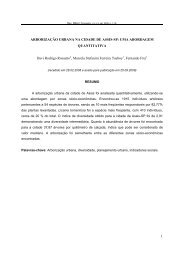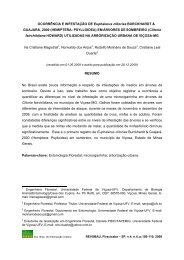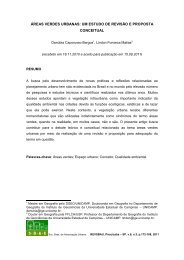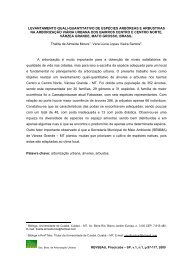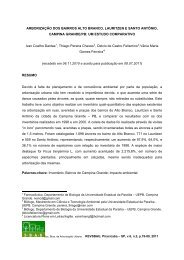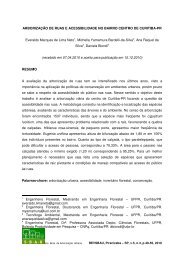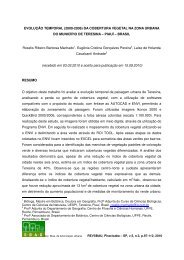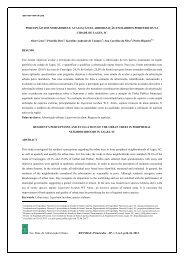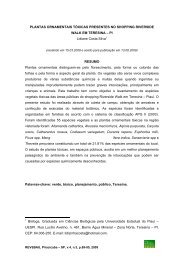aplicação do Ãndice de vegetação ndvi - Revista da Sociedade ...
aplicação do Ãndice de vegetação ndvi - Revista da Sociedade ...
aplicação do Ãndice de vegetação ndvi - Revista da Sociedade ...
Create successful ePaper yourself
Turn your PDF publications into a flip-book with our unique Google optimized e-Paper software.
REVISTA DA SOCIEDADE BRASILEIRA DE ARBORIZAÇÃO URBANA, Volume 2, Número 3, 2007.<br />
APLICAÇÃO DO ÍNDICE DE VEGETAÇÃO NDVI (NORMALIZED DIFFERENCE<br />
VEGETATION INDEX) EM IMAGENS DE ALTA RESOLUÇÃO NO MUNICÍPIO DE SÃO<br />
PAULO E SUAS LIMITAÇÕES<br />
Giuliana Del Nero Velasco 1 , Jefferson Lor<strong>de</strong>llo Polizel 2 , Priscila Pereira Coltri 3 , Ana Maria<br />
Liner Pereira Lima 4 , Demóstenes Ferreira <strong>da</strong> Silva Filho 5<br />
RESUMO<br />
O objetivo <strong>do</strong> trabalho foi testar a aplicação <strong>do</strong> índice <strong>de</strong> vegetação NDVI em imagens <strong>de</strong><br />
alta resolução, em to<strong>da</strong> a área <strong>do</strong> município <strong>de</strong> São Paulo. Foram utiliza<strong>da</strong>s imagens <strong>do</strong><br />
satélite IKONOS II. O programa <strong>de</strong> geoprocessamento utiliza<strong>do</strong> foi o TNT Mips 6.8, <strong>da</strong><br />
MicroImages. O índice aplica<strong>do</strong> foi o NDVI (Normalized Difference Vegetation In<strong>de</strong>x), que<br />
tem como variáveis as ban<strong>da</strong>s <strong>do</strong> vermelho e infravermelho próximo. Notou-se, com a<br />
obtenção <strong>do</strong> índice, uma <strong>de</strong>sigual<strong>da</strong><strong>de</strong> <strong>de</strong> cores, sen<strong>do</strong> níti<strong>da</strong> a presença <strong>de</strong> faixas que não<br />
<strong>de</strong>veriam ter ocorri<strong>do</strong>. Tal fato <strong>de</strong>monstrou a ocorrência <strong>de</strong> algum tipo <strong>de</strong> erro, o que<br />
impedia a obtenção <strong>de</strong> um índice que representasse, fielmente, to<strong>do</strong> o município. Isso ain<strong>da</strong><br />
é reforça<strong>do</strong> pelo fato <strong>do</strong> NDVI ser interpreta<strong>do</strong> por tonali<strong>da</strong><strong>de</strong> <strong>de</strong> cores, ou seja, a variação<br />
na presença <strong>de</strong> vegetação <strong>de</strong>ve ser representa<strong>da</strong> por uma diferença <strong>de</strong> cor; um erro gera<strong>do</strong><br />
no índice, resultan<strong>do</strong> em diferentes faixas <strong>de</strong> tonali<strong>da</strong><strong>de</strong>, po<strong>de</strong>ria prejudicar a correta<br />
interpretação <strong>do</strong> mesmo. Concluiu-se que, para o Município <strong>de</strong> São Paulo, com as imagens<br />
supracita<strong>da</strong>s, <strong>de</strong>ve-se atentar quan<strong>do</strong> <strong>da</strong> aplicação <strong>do</strong> índice <strong>de</strong> vegetação NDVI, não sen<strong>do</strong><br />
possível analisá-lo em to<strong>da</strong> a extensão <strong>do</strong> município, mas sim, apenas <strong>de</strong>ntro <strong>da</strong>s faixas<br />
específicas gera<strong>da</strong>s.<br />
Palavras-Chave: índice <strong>de</strong> vegetação, arborização urbana, sensoriamento remoto.<br />
1 . Engenheira Agrônoma, <strong>do</strong>utoran<strong>da</strong>, ESALQ/USP. Piracicaba-SP, gdnvelas@esalq.usp.br.<br />
2 . Analista <strong>de</strong> Sistema, mestran<strong>do</strong> em geografia, FFLCH/USP. São Paulo-SP, jlpolize@esalq.usp.br<br />
3 . Engenheira agrônoma, bolsista CNPQ, Centro <strong>de</strong> Previsão <strong>de</strong> Tempo e Estu<strong>do</strong>s Climáticos,<br />
CPTEC/INPE, pcoltri@cptec.inpe.br<br />
4 . Engenheira agrônoma, Profa. Dra. Depto. Produção Vegetal, ESALQ/USP. Piracicaba-SP<br />
5 . Engenheiro Agrônomo, Prof. Dr. Depto. <strong>de</strong> Ciências Florestais, ESALQ/USP. Piracicaba-SP,<br />
dfsilva@esalq.usp.br<br />
1
REVISTA DA SOCIEDADE BRASILEIRA DE ARBORIZAÇÃO URBANA, Volume 2, Número 3, 2007.<br />
APPLICATION OF THE INDEX OF VEGETATION NDVI (NORMALIZED DIFFERENCE<br />
VEGETATION INDEX) IN HIGH RESOLUTION IMAGES IN THE CITY OF SÃO PAULO<br />
AND ITS LIMITATIONS<br />
ABSTRACT<br />
The objective of the work was to test the application of the in<strong>de</strong>x of high resolution vegetation<br />
NDVI in images, in all the area of the city of Sao Paulo. The work was <strong>de</strong>veloped with the<br />
use of images of satellite IKONOS II. The program used was TNT MIPS 6,8, of the<br />
MicroImages. The applied in<strong>de</strong>x of vegetation was NDVI (Normalized Difference Vegetation<br />
In<strong>de</strong>x), that it consists of an equation that has as changeable the bands of the red and next<br />
infra-red ray. It was noticed, with the attainment of the in<strong>de</strong>x, an inaquality of colors, being<br />
clear the presence of bands that must not have occurred. Such fact <strong>de</strong>monstrated<br />
occurrence of some type of error, what it hin<strong>de</strong>red the attainment of an in<strong>de</strong>x that<br />
represented, faithful, all the city, from the supplied images. This still is strengthened by the<br />
fact of the NDVI to be interpreted by tonality of colors, that is, the variation in the vegetation<br />
presence must be represented by a color difference; an error generated in the in<strong>de</strong>x,<br />
resulting in different bands of tonality, could harm the correct interpretation of the same. One<br />
conclu<strong>de</strong>d that, with the images of available satellite, must be attempted against when of the<br />
application of the in<strong>de</strong>x of vegetation NDVI, not being possible to analyze it in all the<br />
extension of the city, but yes, only insi<strong>de</strong> of the generated specific bands.<br />
Key-words: vegetation in<strong>de</strong>x, urban arborization, remote sensing<br />
2
REVISTA DA SOCIEDADE BRASILEIRA DE ARBORIZAÇÃO URBANA, Volume 2, Número 3, 2007.<br />
INTRODUÇÃO<br />
O uso <strong>de</strong> imagens <strong>de</strong> satélite para estu<strong>do</strong>s <strong>de</strong> vegetação no ambiente urbano é uma<br />
prática muito utiliza<strong>da</strong> principalmente quan<strong>do</strong> se trata <strong>de</strong> ci<strong>da</strong><strong>de</strong>s <strong>de</strong> gran<strong>de</strong> porte, como é o<br />
caso <strong>do</strong> município <strong>de</strong> São Paulo, com 1.523 km 2 <strong>de</strong> extensão, segun<strong>do</strong> <strong>da</strong><strong>do</strong>s <strong>do</strong> IBGE<br />
(2006). Segun<strong>do</strong> Florenzano (2002), as imagens <strong>de</strong> satélite proporcionam uma visão<br />
sinóptica (<strong>de</strong> conjunto) e multitemporal (<strong>de</strong> dinâmica) <strong>de</strong> extensas áreas <strong>da</strong> superfície<br />
terrestre. Assim, as imagens <strong>de</strong> satélite <strong>da</strong> área permitem uma visão <strong>do</strong> to<strong>do</strong>, possibilitan<strong>do</strong><br />
a obtenção <strong>de</strong> informações que seriam inviáveis <strong>de</strong> serem adquiri<strong>da</strong>s sem a utilização <strong>da</strong>s<br />
mesmas.<br />
O satélite Ikonos II, consi<strong>de</strong>ra<strong>do</strong> <strong>de</strong> altíssima resolução espacial (1m na<br />
pancromática e 4m na multiespectral), foi coloca<strong>do</strong> na órbita em 24 <strong>de</strong> setembro <strong>de</strong> 1999 a<br />
uma altitu<strong>de</strong> <strong>de</strong> 680 km, operan<strong>do</strong> nos comprimentos <strong>de</strong> on<strong>da</strong> entre 400 e 1.100 nm.<br />
(Moreira, 2005).<br />
O mesmo autor afirma que ca<strong>da</strong> alvo (asfalto, vegetação, água, entre outros) tem<br />
comportamento espectral diferente na mesma condição ambiental. A água apresenta a mais<br />
baixa reflectância e absorve to<strong>da</strong> a radiação acima <strong>de</strong> 750nm. O asfalto não ultrapassa 10%<br />
no valor <strong>da</strong> reflectância. Segun<strong>do</strong> Tucker, (1979), cita<strong>do</strong> por Moreira (2005), a vegetação é<br />
caracteriza<strong>da</strong> por uma intensa absorção <strong>de</strong>vi<strong>do</strong> à clorofila na região <strong>do</strong> vermelho (0,58 a<br />
0,68µm) e por uma intensa reflexão na faixa <strong>do</strong> infravermelho próximo (0,76 a 1,35 µm)<br />
causa<strong>da</strong> pela estrutura celular <strong>da</strong>s folhas. A diferença entre as ban<strong>da</strong>s <strong>do</strong> vermelho e<br />
infravermelho é proporcional à reflectância <strong>da</strong> imagem, sen<strong>do</strong> a medi<strong>da</strong> <strong>do</strong> grau <strong>de</strong><br />
vegetação na imagem. Moreira (2005) afirma que os <strong>da</strong><strong>do</strong>s <strong>de</strong> reflectância <strong>do</strong>s alvos po<strong>de</strong>m<br />
ser transforma<strong>do</strong>s em índices <strong>de</strong> vegetação, os quais foram cria<strong>do</strong>s com o intuito <strong>de</strong><br />
ressaltar o comportamento espectral <strong>da</strong> vegetação em relação ao solo e a outros alvos <strong>da</strong><br />
superfície terrestre, sen<strong>do</strong> que um <strong>do</strong>s índices mais utiliza<strong>do</strong>s é o NDVI (Normalized<br />
Difference Vegetation In<strong>de</strong>x).<br />
O objetivo <strong>do</strong> presente trabalho foi testar a aplicação <strong>do</strong> índice <strong>de</strong> vegetação NDVI<br />
em imagens <strong>de</strong> alta resolução, em to<strong>da</strong> a área <strong>do</strong> município <strong>de</strong> São Paulo.<br />
MATERIAL E MÉTODOS<br />
Foram utiliza<strong>da</strong>s imagens <strong>do</strong> satélite IKONOS II, cedi<strong>da</strong>s pelo Instituto Geológico,<br />
vincula<strong>do</strong> à Secretaria <strong>do</strong> Meio Ambiente <strong>do</strong> Governo <strong>do</strong> Esta<strong>do</strong> <strong>de</strong> São Paulo. As imagens<br />
foram tira<strong>da</strong>s no ano <strong>de</strong> 2002 e ca<strong>da</strong> cena comporta uma área <strong>de</strong> 5 x 5 km. Foram<br />
forneci<strong>da</strong>s no formato geotiff nas ban<strong>da</strong>s azul (blue), vermelho (red), ver<strong>de</strong> (green),<br />
infravermelho próximo (NIR) e na composição vermelho-ver<strong>de</strong>-azul (RGB).<br />
3
REVISTA DA SOCIEDADE BRASILEIRA DE ARBORIZAÇÃO URBANA, Volume 2, Número 3, 2007.<br />
Para abranger to<strong>do</strong> o município <strong>de</strong> São Paulo, foram necessárias 67 cenas <strong>do</strong><br />
satélite. O programa <strong>de</strong> geoprocessamento utiliza<strong>do</strong> para realização <strong>da</strong> presente etapa <strong>da</strong><br />
pesquisa foi o TNT Mips 6.8, <strong>da</strong> MicroImages.<br />
Para a obtenção <strong>do</strong> índice, as seguintes etapas foram segui<strong>da</strong>s:<br />
Geração <strong>de</strong> mosaicos<br />
Foram gera<strong>do</strong>s <strong>do</strong>is mosaicos, um <strong>da</strong> ban<strong>da</strong> RED e um <strong>da</strong> NIR, os quais consistiram<br />
em um agrupamento <strong>da</strong>s 67 cenas correspon<strong>de</strong>ntes à área <strong>do</strong> Município, tal qual um<br />
quebra-cabeça, resultan<strong>do</strong> em um mosaico composto por uma só cena engloban<strong>do</strong> to<strong>do</strong> o<br />
município. A etapa foi feita utilizan<strong>do</strong> as ferramentas “process”, “raster”, “mosaic” <strong>do</strong><br />
programa utiliza<strong>do</strong>.<br />
Aplicação <strong>do</strong> Índice <strong>de</strong> vegetação:<br />
O índice <strong>de</strong> vegetação utiliza<strong>do</strong> no presente trabalho foi o NDVI (Normalized Difference<br />
Vegetation In<strong>de</strong>x), o qual consiste em uma equação que tem como variáveis as ban<strong>da</strong>s <strong>do</strong><br />
vermelho e infravermelho próximo, como se segue:<br />
NDVI: IVP – V / IVP + V (1)<br />
On<strong>de</strong>,<br />
IVP: valor <strong>da</strong> reflectância <strong>da</strong> ban<strong>da</strong> no Infravermelho próximo<br />
V: valor <strong>de</strong> reflectância <strong>da</strong> ban<strong>da</strong> no vermelho<br />
O índice também foi obti<strong>do</strong> pelo programa TNT Mips através <strong>da</strong>s etapas “process”,<br />
“raster”, “combine”, “pre<strong>de</strong>fined”.<br />
Análise <strong>do</strong> índice e <strong>de</strong> suas limitações<br />
Nesta etapa foi analisa<strong>do</strong> o índice <strong>de</strong> vegetação e seus problemas e limitações,<br />
tentan<strong>do</strong> corrigi-los.<br />
RESULTADOS E DISCUSSÃO<br />
O mosaico <strong>da</strong>s 67 cenas <strong>da</strong>s ban<strong>da</strong>s NIR e RED po<strong>de</strong>m ser vistos nas figuras 1 e 2,<br />
respectivamente.<br />
4
REVISTA DA SOCIEDADE BRASILEIRA DE ARBORIZAÇÃO URBANA, Volume 2, Número 3, 2007.<br />
Figura 1. Mosaico <strong>da</strong>s 67 cenas <strong>da</strong> ban<strong>da</strong> NIR compreen<strong>de</strong>n<strong>do</strong> o Município <strong>de</strong> São<br />
Paulo.<br />
Paulo.<br />
Figura 2. Mosaico <strong>da</strong>s 67 cenas <strong>da</strong> ban<strong>da</strong> RED compreen<strong>de</strong>n<strong>do</strong> o Município <strong>de</strong> São<br />
5
REVISTA DA SOCIEDADE BRASILEIRA DE ARBORIZAÇÃO URBANA, Volume 2, Número 3, 2007.<br />
O índice <strong>de</strong> vegetação gera<strong>do</strong> po<strong>de</strong> ser visto na figura 3.<br />
Figura 3. Índice <strong>de</strong> vegetação (NDVI).<br />
A figura 4 mostra o NDVI e o limite que confere o Município <strong>de</strong> São Paulo.<br />
Figura 4. Índice <strong>de</strong> vegetação NDVI com limite <strong>do</strong> Município <strong>de</strong> SP<br />
6
REVISTA DA SOCIEDADE BRASILEIRA DE ARBORIZAÇÃO URBANA, Volume 2, Número 3, 2007.<br />
Notou-se com a obtenção <strong>do</strong> índice, uma <strong>de</strong>sigual<strong>da</strong><strong>de</strong> <strong>de</strong> cores, sen<strong>do</strong> níti<strong>da</strong> a<br />
presença <strong>de</strong> faixas verticais que não <strong>de</strong>veriam ter ocorri<strong>do</strong>, já que <strong>de</strong>ntro <strong>de</strong> faixas <strong>de</strong> cores<br />
diferentes, quan<strong>do</strong> estu<strong>da</strong><strong>da</strong>s separa<strong>da</strong>mente, ocorriam os mesmos tipos <strong>de</strong> vegetação. Tal<br />
fato <strong>de</strong>monstrou a ocorrência <strong>de</strong> algum tipo <strong>de</strong> erro o que impedia a obtenção <strong>de</strong> um índice<br />
que representasse, fielmente, to<strong>do</strong> o município. Isso ain<strong>da</strong> é reforça<strong>do</strong> pelo fato <strong>do</strong> NDVI ser<br />
interpreta<strong>do</strong> por tonali<strong>da</strong><strong>de</strong> <strong>de</strong> cores, ou seja, a variação na presença <strong>de</strong> vegetação <strong>de</strong>ve ser<br />
representa<strong>da</strong> por uma diferença <strong>de</strong> cor; um erro gera<strong>do</strong> no índice resultan<strong>do</strong> em diferentes<br />
faixas <strong>de</strong> tonali<strong>da</strong><strong>de</strong> po<strong>de</strong>ria prejudicar a correta interpretação <strong>do</strong> mesmo.<br />
Com isso, iniciou-se uma tentativa <strong>de</strong> corrigir essa diferença na tonali<strong>da</strong><strong>de</strong> <strong>do</strong> índice<br />
através <strong>de</strong> ferramentas forneci<strong>da</strong>s pelo software utiliza<strong>do</strong>. Os mosaicos foram gera<strong>do</strong>s<br />
novamente, bem como o índice, para conferir se o procedimento tinha si<strong>do</strong> feito <strong>de</strong> maneira<br />
correta, mas não houve diferença no resulta<strong>do</strong>. Também foram feitos diversos testes com a<br />
geração <strong>do</strong>s mosaicos e a aplicação <strong>de</strong> filtros <strong>de</strong> normalização e equalização (“normalize” e<br />
“equalize”), no intuito <strong>de</strong> homogeneizar a tonali<strong>da</strong><strong>de</strong>, mas os resulta<strong>do</strong>s não foram positivos.<br />
Assim, as cenas foram estu<strong>da</strong><strong>da</strong>s individualmente e <strong>de</strong>scobriu-se que a diferença <strong>de</strong><br />
tonali<strong>da</strong><strong>de</strong> estava <strong>de</strong>ntro <strong>de</strong> ca<strong>da</strong> cena, ou seja, gran<strong>de</strong> parte <strong>da</strong>s cenas forneci<strong>da</strong>s estava<br />
com essa diferença <strong>de</strong> cor. Uma possível explicação para esse problema é a <strong>de</strong> que as<br />
cenas foram obti<strong>da</strong>s no ano <strong>de</strong> 2002 e algumas foram corrigi<strong>da</strong>s no ano seguinte, po<strong>de</strong>n<strong>do</strong><br />
gerar tal diferença.<br />
Com essa constatação, e com a impossibili<strong>da</strong><strong>de</strong> <strong>de</strong> obter-se outras cenas, procurouse<br />
corrigir aquelas que apresentavam tal problema, uma a uma, para assim gerar<br />
novamente os mosaicos e em segui<strong>da</strong> o índice <strong>de</strong> vegetação.<br />
Assim, soman<strong>do</strong> as ban<strong>da</strong>s <strong>do</strong> vermelho e infravermelho, totalizavam 134 cenas a<br />
serem corrigi<strong>da</strong>s. O procedimento feito foi o <strong>de</strong>, cena a cena, dividi-la em <strong>do</strong>is pe<strong>da</strong>ços,<br />
exatamente no limite on<strong>de</strong> estava a diferença <strong>de</strong> coloração e então gerar novo mosaico <strong>do</strong>s<br />
<strong>do</strong>is pe<strong>da</strong>ços, com a aplicação <strong>de</strong> um filtro <strong>de</strong> equalização (“equalize”) no intuito <strong>de</strong><br />
homogeneizar a tonali<strong>da</strong><strong>de</strong> <strong>de</strong>ntro <strong>de</strong> ca<strong>da</strong> cena.<br />
figura 5.<br />
Um exemplo <strong>de</strong> uma cena que apresenta diferença na tonali<strong>da</strong><strong>de</strong> po<strong>de</strong> ser visto na<br />
7
REVISTA DA SOCIEDADE BRASILEIRA DE ARBORIZAÇÃO URBANA, Volume 2, Número 3, 2007.<br />
Figura 5. Cena NIR mostran<strong>do</strong> diferença na tonali<strong>da</strong><strong>de</strong>.<br />
A figura 6 mostra a cena dividi<strong>da</strong> em <strong>do</strong>is polígonos exatamente no limite em que<br />
ocorre a diferença <strong>de</strong> tonali<strong>da</strong><strong>de</strong>.<br />
Figura 6. Cena corta<strong>da</strong> na região <strong>da</strong> diferença <strong>de</strong> tonali<strong>da</strong><strong>de</strong>.<br />
8
REVISTA DA SOCIEDADE BRASILEIRA DE ARBORIZAÇÃO URBANA, Volume 2, Número 3, 2007.<br />
Depois <strong>de</strong> corta<strong>da</strong> em <strong>do</strong>is pe<strong>da</strong>ços, as cenas foram novamente uni<strong>da</strong>s, agora com o<br />
uso <strong>do</strong> filtro “equalize”. A figura 7 mostra a cena recomposta já com a aplicação <strong>do</strong> filtro.<br />
Figura 7. Cena mosaica<strong>da</strong> com uso <strong>do</strong> filtro “equalize”.<br />
Notou-se com a aplicação <strong>do</strong> filtro que a cena ficou mais homogênea em termos <strong>de</strong><br />
coloração, embora ain<strong>da</strong> fosse possível notar diferença <strong>de</strong> cor. Assim, foi feito o mesmo<br />
procedimento nas 134 cenas, ou seja, ca<strong>da</strong> cena foi dividi<strong>da</strong> em <strong>do</strong>is pe<strong>da</strong>ços e estes<br />
uni<strong>do</strong>s com o uso <strong>do</strong> filtro “equalize”, voltan<strong>do</strong> a ser uma só cena. Em segui<strong>da</strong> foi feito o<br />
mosaico <strong>da</strong>s 67 cenas <strong>do</strong> NIR e <strong>da</strong>s 67 cenas <strong>do</strong> RED, resultan<strong>do</strong> novamente em duas<br />
cenas (uma <strong>de</strong> ca<strong>da</strong> ban<strong>da</strong>) abrangen<strong>do</strong> o Município <strong>de</strong> SP, agora equaliza<strong>da</strong>s.<br />
Os mosaicos já equaliza<strong>do</strong>s <strong>da</strong>s ban<strong>da</strong>s NIR e RED po<strong>de</strong>m ser vistos nas figuras 8 e<br />
9, respectivamente.<br />
9
REVISTA DA SOCIEDADE BRASILEIRA DE ARBORIZAÇÃO URBANA, Volume 2, Número 3, 2007.<br />
Figura 8. Mosaico NIR equaliza<strong>do</strong>.<br />
Figura 9. Mosaico Red equaliza<strong>do</strong>.<br />
A etapa seguinte foi aplicar o índice NDVI com o uso <strong>do</strong>s mosaicos NIR e RED<br />
equaliza<strong>do</strong>s. O resulta<strong>do</strong> <strong>do</strong> índice po<strong>de</strong> ser visto na figura 10.<br />
10
REVISTA DA SOCIEDADE BRASILEIRA DE ARBORIZAÇÃO URBANA, Volume 2, Número 3, 2007.<br />
Figura 10. Índice NDVI equaliza<strong>do</strong>.<br />
Notou-se com a figura que a aplicação <strong>do</strong> filtro “equalize” não solucionou os<br />
problemas <strong>de</strong> diferença <strong>de</strong> tonali<strong>da</strong><strong>de</strong>: embora tenha havi<strong>do</strong> uma relativa homogeneização<br />
<strong>da</strong>s faixas anteriormente vistas, notou-se uma fragmentação <strong>da</strong>s cenas, sen<strong>do</strong> possível<br />
i<strong>de</strong>ntificar as 67 cenas, o que não ocorre quan<strong>do</strong> o resulta<strong>do</strong> <strong>do</strong> índice é correto.<br />
Cabe ressaltar que as imagens <strong>do</strong> satélite IKONOS que foram utiliza<strong>da</strong>s para gerar<br />
tal índice são as únicas existentes para o município <strong>de</strong> São Paulo, sen<strong>do</strong> as mesmas<br />
utiliza<strong>da</strong>s para outros estu<strong>do</strong>s. O presente estu<strong>do</strong> po<strong>de</strong>rá servir <strong>de</strong> base para futuros<br />
trabalhos, principalmente pela <strong>de</strong>tecção <strong>da</strong> presença <strong>de</strong> tal erro. Futuros estu<strong>do</strong>s já po<strong>de</strong>m<br />
partir <strong>do</strong> princípio que o índice <strong>de</strong> vegetação NDVI com imagens <strong>do</strong> satélite IKONOS s’po<strong>de</strong><br />
ser utiliza<strong>do</strong> em partes, <strong>de</strong>ntro <strong>de</strong> ca<strong>da</strong> faixa, não po<strong>de</strong>n<strong>do</strong> ser analisa<strong>do</strong> <strong>de</strong> forma<br />
homogênea em to<strong>do</strong> o município.<br />
CONCLUSÕES<br />
Concluiu-se que, para Município <strong>de</strong> São Paulo, com as imagens <strong>do</strong> satélite IKONOS<br />
disponíveis, <strong>de</strong>ve-se atentar quan<strong>do</strong> <strong>da</strong> aplicação <strong>do</strong> índice <strong>de</strong> vegetação NDVI, não sen<strong>do</strong><br />
possível analisá-lo em to<strong>da</strong> a extensão <strong>do</strong> município, mas sim, apenas <strong>de</strong>ntro <strong>da</strong>s faixas<br />
específicas gera<strong>da</strong>s.<br />
11
REVISTA DA SOCIEDADE BRASILEIRA DE ARBORIZAÇÃO URBANA, Volume 2, Número 3, 2007.<br />
AGRADECIMENTOS<br />
Os autores agra<strong>de</strong>m à FAPESP – Fun<strong>da</strong>ção <strong>de</strong> Amparo à Pesquisa <strong>do</strong> Esta<strong>do</strong> <strong>de</strong><br />
São Paulo pela concessão <strong>da</strong> bolsa <strong>de</strong> <strong>do</strong>utora<strong>do</strong> no qual o presente estu<strong>do</strong> está inseri<strong>do</strong>.<br />
REFERÊNCIAS BIBLIOGRÁFICAS<br />
Florenzano, T. G. Imagens <strong>de</strong> satélite para estu<strong>do</strong>s ambientais. Oficina <strong>de</strong> textos, 2002.<br />
São Paulo. 97p.<br />
INSTITUTO BRASILEIRO DE GEOGRAFIA E ESTATÍSTICA- IBGE. Disponível em<br />
http://www.ibge.gov.br . Acesso em: 06set. 2006.<br />
Moreira, M. A. Fun<strong>da</strong>mentos <strong>do</strong> sensoriamento remoto e meto<strong>do</strong>logias <strong>de</strong> aplicação. 3ª<br />
edição. 2005. Editora UFV.320p.<br />
12



